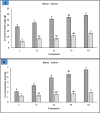Enhancing Sesbania sesban L. (Merr.) growth and metal resilience by synergistic application of Trichoderma harzianum loaded biochar and biochar-zinc oxide nanocomposite
- PMID: 40481405
- PMCID: PMC12142915
- DOI: 10.1186/s12870-025-06717-1
Enhancing Sesbania sesban L. (Merr.) growth and metal resilience by synergistic application of Trichoderma harzianum loaded biochar and biochar-zinc oxide nanocomposite
Abstract
Heavy metals in agricultural soil are hazardous to the environment and human beings. So, the current study was hypothesized that Trichoderma harzianum maize biochar (MBT), and maize biochar zinc oxide nanocomposite (MB-ZnO) could effectively stabilize Cd and Cu in a polluted soil and evaluate their synergistic effects on Sesbania sesban L. (Merr.) growth. The biochar zinc oxide nanocomposite and T. harzianum loaded biochar were systematically characterized before applications. In this study, both types of engineered biochar (MB-ZnO nanocomposite and MBT) were applied to influence the growth of S. sesban. These plants were sprayed with various doses (0, 50, 75, 100 mg/L) of MB-ZnO nanocomposite and 2.0% (w/w) MBT. Foliar application of 100 mg/L MB-ZnO nanocomposite clearly reduced Cd and Cu content in the shoots of S. sesban by 30% and 31%, respectively. The combined application of MB-ZnO increased SOD (33.33%), and POD (37.5%) at the concentration of 100 mg /L. Co-applied application of MB-ZnO nanocomposite and MBT diminished Cd and Cu content by 39% and 38%, respectively, and increased soil pH (8.03 to 8.23). Conclusive findings of this study established that the application of the engineered biochar (MB-ZnO nanocomposite and MBT) is an environment-friendly and efficient way to immobilize toxic metals from the soil and improve the physiological, biochemical, anatomical, and antioxidant enzyme activities of the S. sesban plant.
Keywords: MB-ZnO nanocomposite; Metal immobilization; Plant growth; Sustainable agriculture; Trichoderma loaded biochar.
© 2025. The Author(s).
Conflict of interest statement
Declarations. Ethics approval and concent to participate: Not applicable. Consent for publication: Not applicable. Competing interests: The authors declare no competing interests.
Figures















Similar articles
-
Trichoderma harzianum-loaded maize biochar enhances Cd-Cu immobilization and reduces bio-accessibility in contaminated soil.Sci Rep. 2025 Aug 1;15(1):28099. doi: 10.1038/s41598-025-13759-w. Sci Rep. 2025. PMID: 40751076 Free PMC article.
-
Alleviation of cadmium accumulation in maize (Zea mays L.) by foliar spray of zinc oxide nanoparticles and biochar to contaminated soil.Environ Pollut. 2019 May;248:358-367. doi: 10.1016/j.envpol.2019.02.031. Epub 2019 Feb 19. Environ Pollut. 2019. PMID: 30818115
-
Combined use of biochar and zinc oxide nanoparticle foliar spray improved the plant growth and decreased the cadmium accumulation in rice (Oryza sativa L.) plant.Environ Sci Pollut Res Int. 2019 Apr;26(11):11288-11299. doi: 10.1007/s11356-019-04554-y. Epub 2019 Feb 22. Environ Sci Pollut Res Int. 2019. PMID: 30793248
-
Co-application of biochar and microorganisms improves soybean performance and remediate cadmium-contaminated soil.Ecotoxicol Environ Saf. 2021 May;214:112112. doi: 10.1016/j.ecoenv.2021.112112. Epub 2021 Mar 11. Ecotoxicol Environ Saf. 2021. PMID: 33714140
-
Simultaneous immobilization strategy of anionic metalloids and cationic metals in agricultural systems: A review.Chemosphere. 2024 Sep;364:143106. doi: 10.1016/j.chemosphere.2024.143106. Epub 2024 Aug 15. Chemosphere. 2024. PMID: 39153530 Review.
Cited by
-
Effects of Different Modified Biochars on Growth of Kosteletzkya virginica and Corresponding Transcriptome Analysis.Plants (Basel). 2025 Jun 16;14(12):1849. doi: 10.3390/plants14121849. Plants (Basel). 2025. PMID: 40573837 Free PMC article.
References
-
- Brillas E, Martínez-Huitle CA. Decontamination of wastewaters containing synthetic organic dyes by electrochemical methods. An updated review. Appl Catal B. 2015;166:603–43.
-
- Ndiaye E, Sandeno J, McGrath D, Dick R. Integrative biological indicators for detecting change in soil quality. Am J Altern Agric. 2000;15(1):26–36.
-
- Qadir A, Malik RN. Heavy metals in eight edible fish species from two polluted tributaries (Aik and Palkhu) of the River Chenab. Pak Biol Trace Element Res. 2011;143(3):1524–40. - PubMed
-
- Pueyo M, López-Sánchez J, Rauret G. Assessment of CaCl2, NaNO3 and NH4NO3 extraction procedures for the study of Cd, Cu, Pb and Zn extractability in contaminated soils. Anal Chim Acta. 2004;504(2):217–26.
-
- Filipiak-Szok A, Kurzawa M, Szłyk E. Determination of toxic metals by ICP-MS in Asiatic and European medicinal plants and dietary supplements. J Trace Elem Med Biol. 2015;30:54–8. - PubMed
MeSH terms
Substances
Supplementary concepts
LinkOut - more resources
Full Text Sources
Miscellaneous

